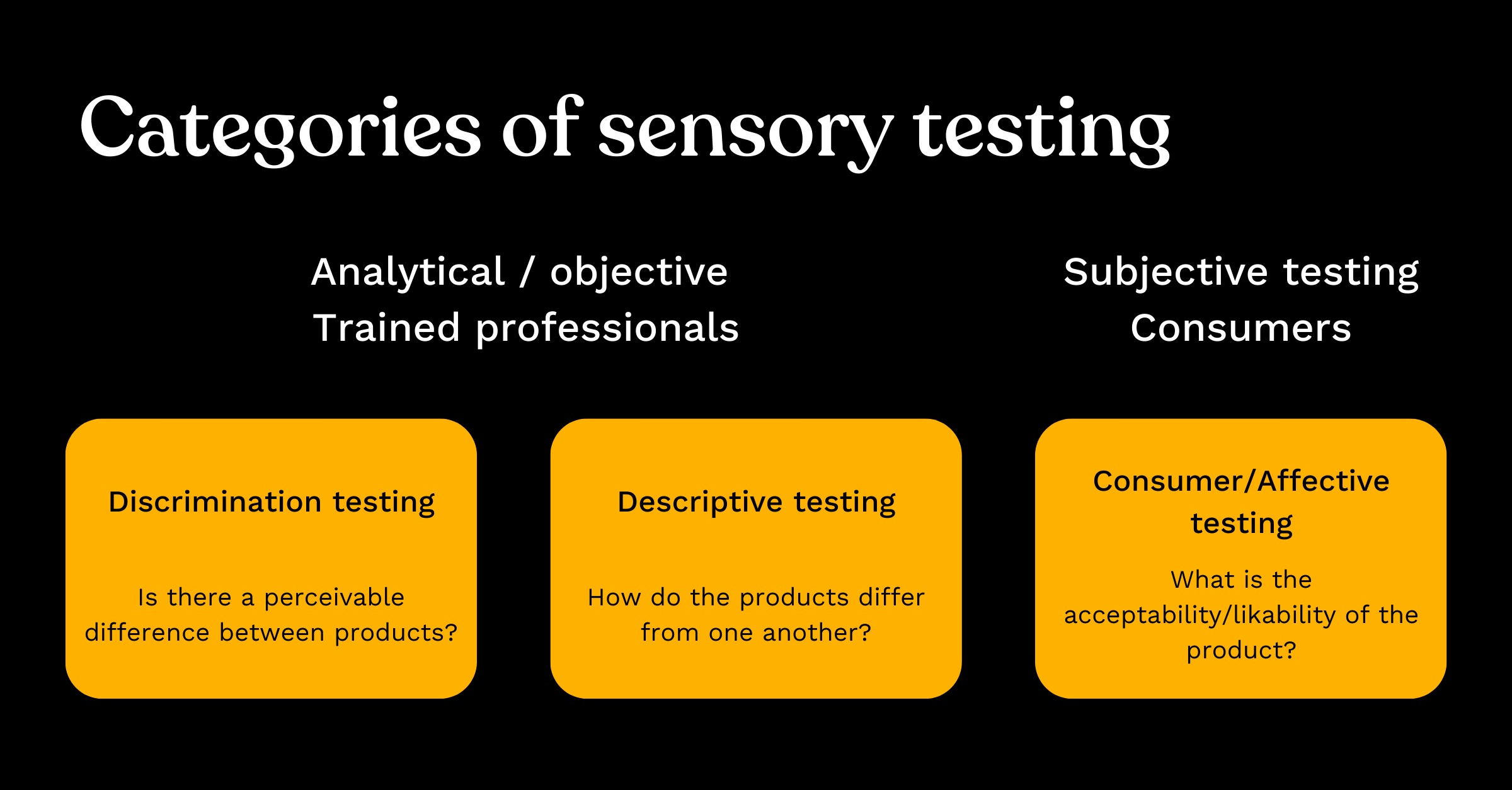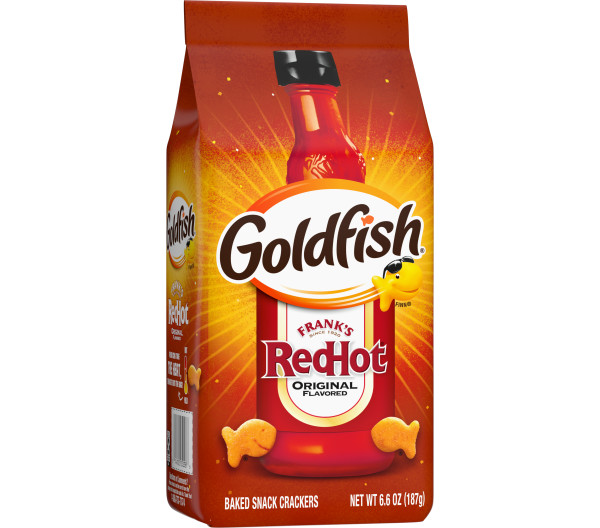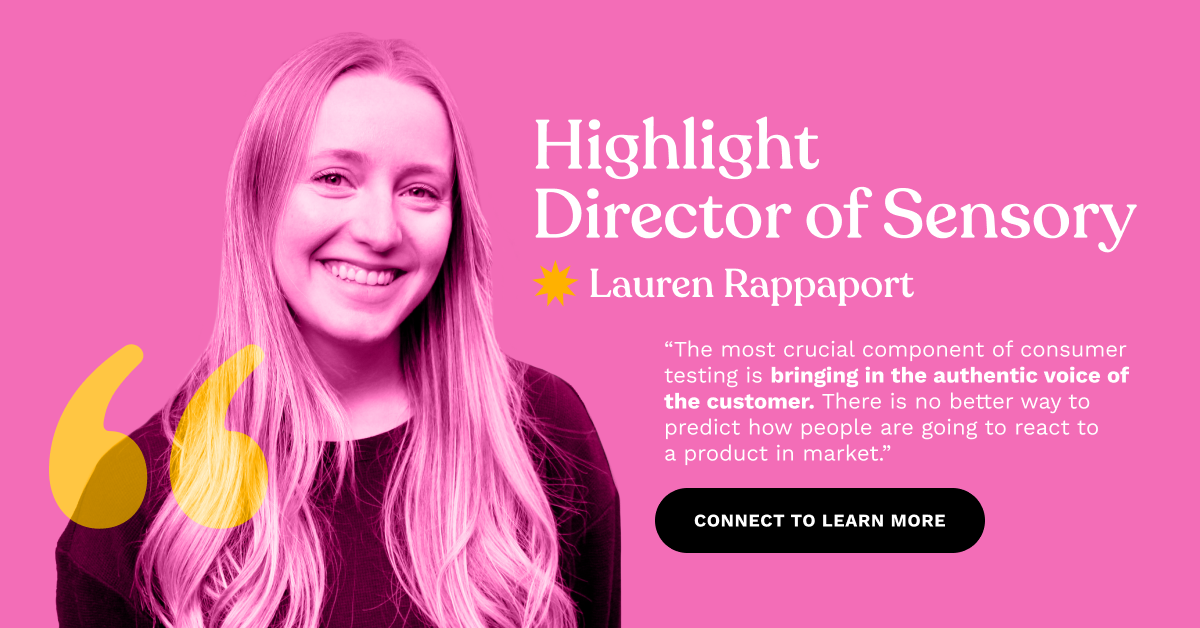Our enjoyment of a product begins long before we start consuming it.
It might begin with eye-catching packaging design or an unboxing experience that makes you feel like a little kid on Christmas morning. It could be the smell as you open the container, or the color after you pour it.
This all-encompassing experience extends beyond food. It could be the feel of fabric against your skin (looking at you Kristin Davis), shampoo that smells like your favorite vacation destination, or the way a facial serum feels soaking into your skin.
Actor Kristin Davis helped promote Jacquemus < Les Sculptures > with an Instagram reel showing the importance of creating a full sensory experience.
If you’re not craving your favorite product experience yet, you might find yourself thinking of your favorites by the time you’re done reading this interview with Highlight’s Director of Sensory, Lauren Rappaport.
Lauren is a food scientist with multiple advanced degrees, a specialty in sensory testing, and experience with iconic brands like Daiya and Starbucks. She’s a person who truly appreciates the sensory details that take a product from useful to irresistible.
Naturally, we had to learn more–about Lauren’s expertise, sure–but also about the life experiences that inspired her to choose a career fully dedicated to creating products that delight consumers everywhere. Here’s what we learned:
See how sensory testing can set your product apart
Tour the Highlight Platform
Get your questions answered and see the platform in action with a personalized demo.
Highlight: Why don't we start, if you don't mind, with your “elevator pitch”? Introduce yourself, how you came to this path of work, and why you came to it.
Lauren: Sure! I did my undergrad in Food Science and Nutritional Science. I knew I didn't want to be a dietitian, but I knew I loved food.
In my 3rd year of university, I did a semester abroad in England. I studied at the University of Nottingham, and I was really limited in the courses that I could take that would transfer back to credits towards my degree.
One of the courses that I was able to take was called “Sensory Evaluation”. I had never heard of it before! I did not know it existed whatsoever, but it counted towards my degree. So I decided to take it. Why not?
Turns out, I found it super interesting. So that was when I added Food Science as a second major to my degree in Nutritional Science. And I had to do five years of undergrad because of the two majors.
Highlight: So clearly you loved food science.
Lauren: Clearly! And then I even went on to do a Master’s program after that, which included a practicum so I could get industry experience.
Highlight: And where did you find yourself after that?
Lauren: There are two common routes you can go when you study food science. You can go into quality assurance or you can go into product development. I knew I wanted to go the product development route. My first job out of university was in product development for a granola bar manufacturer which I really enjoyed. Then a position came up at Daiya Foods within the sensory team that really interested me, so I decided to pursue that.
During my time at Daiya, I completed an online program in Sensory and Consumer Science from Penn State. And from there, I transitioned to Starbucks where I joined the sensory team.
Highlight: Are you a coffee fan?
Lauren: When I was in university, I worked as a barista for about four years at Starbucks, and it was always a dream of mine to go work in their corporate office some day. And that dream came to life with the sensory position. And now here I am today, at Highlight!
“When I was in university, I worked as a barista for about four years at Starbucks, and it was always a dream of mine to go work in their corporate office some day.”
Highlight: What's the difference between working on a team that is developing a product for grocery stores versus one for the context of a retail experience?
Lauren: It's a really different mindset. If you think about the objectives of product development, there are a lot of different considerations that you have to make for a CPG product versus the QSR [quick-service restaurant] world.
Typically, within CPG you are producing a product on a super large scale, and so for the most part, it's a fairly controlled environment and you know exactly what you're going to get every time you manufacture the product. But with that comes a lot of quality control, and that's where a lot of sensory testing comes into play within production facilities.
In the QSR world, people are your variables. If you go into a Starbucks store, as much as you want to control the process of how the finished product comes to be, there is some level of variability that you just have to accept.
In CPG, there's a lot of different ways that you can test, and home usage or in-context testing is the perfect scenario to look into someone's natural environment.
Highlight: Does sensory testing vary within CPG as well? Like, if you’re a personal care brand, you may not be producing an edible product, but is sensory testing still relevant?
Lauren: From a methodology standpoint, sensory testing is applicable to so many different categories. The nuances that bring it to life make for some differences, but I’m very excited to see it come to life in all the different industries that we support.
“Sensory testing is applicable to so many different categories. The nuances that bring it to life make for some differences, but I’m very excited to see it come to life in all the different industries that we support.”
Highlight: How might sensory testing differ by category?
Lauren: Food and bev is probably the most generally known for sensory testing. But cosmetics and personal care is the next biggest one, whether it's skincare or shampoos, body washes, deodorant, and different things like that. Oftentimes, there are a lot of claims associated with skincare products, for example , “X percent of consumers saw a noticeable reduction in wrinkles,” where I think sensory testing and claim substantiation should play a huge role.
Within the pet care industry, like for different pet foods, you're analyzing the animal, but you’re also talking to the owner and gaining those sensory insights indirectly. [Highlight aside: Our dedicated “pet panels” can provide these tricky-to-tackle insights! Here’s one example of how it’s done for cat litter.]
Sensory is also important in apparel and wear testing. The biggest names in athletic wear, like Nike and Lululemon, place a huge emphasis on wear and sensory testing with their products. They need to prove functionality and there’s no better way to do that than in-context learning.
Highlight: This might seem like an obvious question, but can you spell it out really simply: Why is sensory testing important? Why is it important for a skincare brand that has a certain scent? Or for a dog food brand selling both wet and dry SKU?
Lauren: When we say sensory testing, there are actually a lot of different things that fall under that umbrella. There are three main buckets. You have discrimination testing, which is used to determine whether consumers can notice a difference between products. That might be used to optimize cost or change an ingredient because of supply chain issues. We want to know, “Can we make this change without impacting the sensory perception of the product?”

The next big bucket of sensory testing is descriptive testing, and that’s determining how products differ. Where you see that come to life most clearly is flavor profiling. For example, sommeliers and a wine wheel where you have all these different flavor profiles to describe wine. This is a methodology that requires highly trained individuals who have very good sensory palates, are able to articulate and identify different sensory attributes, and can quantify the intensity of those attributes.
The final bucket is consumer testing, which is where you bring in voice of the customer. The most crucial component of consumer testing is bringing in the authentic voice of the customer. There is no better way to predict how people are going to react to a product in market.
A lot of times within brands and companies, the people developing the products and the people making the decisions are not the target consumer. So consumer testing mitigates the risk of relying on internal decisions by pulling in the voice of the consumers who really matter to you, so you can make the best products that you can, hear their point of view, and develop your product utilizing robust research methodologies.
"Consumer testing mitigates the risk of relying on internal decisions by pulling in the voice of the consumers who really matter to you."
Highlight: Let’s jump into some just-for-fun questions. Are there any brands you’ve tried recently that gave you a sensory experience that really surprised or delighted you?
Lauren: This probably won’t surprise you, but I feel like I am hypersensitive to most food and beverage products that I try throughout my day. I pick apart everything I eat. I do it in my job, I do it in my life. It's kind of all-encompassing.
“I pick apart everything I eat. I do it in my job, I do it in my life. It's kind of all-encompassing.”
But I just had a snack, and I thought, this is the perfect example of a great product: Frank's Red Hot Goldfish. It’s such an interesting collab of two products that I absolutely love on their own. With Goldfish, you have that salty, crunchy, light, airiness, and then obviously Frank's Red Hot goes well with everything. You put those two together–something that you might think is so random–but the way that they perfectly capture the flavor profile of Frank's within the Goldfish is incredible to me. If you close your eyes, you would think that you just dipped a Goldfish in Frank's Red Hot–which I actually do sometimes. They’re definitely meeting an unmet need! Making my life easier and bringing it to life in a packaged product.
Highlight: We are obsessed with Goldfish at Highlight. We talk about them a lot.
Lauren: Oh, that's funny. I totally support incorporating Goldfish into everything that we publish!

“The snack that smiles back” keeps innovating new flavors consumers love
Highlight: On that note, let’s talk a bit about some of your early experiences, like from childhood or when you were a teenager, that gave you an appreciation for the sensorial experiences you can have from food.
Lauren: My dad owns a restaurant and deli, so for my entire life, we've always just been surrounded by food. My grandparents all loved to cook and bake, and so it's just something that I’ve been immersed in for as long as I can remember. There's always been a heavy focus on food in my family. So my dad is in the food industry, my sister is also in the food industry–it's only natural for me to also be in the food industry.
It’s all come together as something that I love, and now I also get to do it as a career. I feel like it's the best of both worlds.
Highlight: Can you name your top five favorite sensorial experiences?
Lauren: Coffee is my main one. Like the sound of beans grinding or the smell of freshly brewed coffee. Even the temperature! I’m such a ritual person when it comes to my coffee in the morning. I love coffee, but I also need to do the ritual of having coffee. So I always start my morning with a hot brewed coffee. Just black, nothing in it. I’m very particular about that. That's a whole sensory experience in itself. You get the sound. You get the smell. You get the taste. You get the temperature. It’s an all-encompassing sensory experience.
“I love coffee, but I also need to do the ritual of having coffee. So I always start my morning with a hot brewed coffee. Just black, nothing in it. I’m very particular about that.”
Highlight: Okay, that’s one.
Lauren: What's another one? I feel like anytime there are good textures in food, I love it. I can’t eat a bowl of oatmeal. I’m not a fan of mushy textures. But contrary to that, a crispy sourdough bread–there's nothing better.
Okay number three: Going in the ocean. But actually it’s the smell of saltwater, and the sound of waves crashing, just being around the ocean. And also the feeling of walking outside and the sun hitting your face–that warm feeling, I absolutely love. Being in the Pacific Northwest, we get a lot of rain, and so those buckets of sunshine hit especially hard.
Highlight: I was going to say, these are all very Pacific Northwest answers! Okay, last question: Have you ever traveled somewhere where you got to experience a totally different food culture and sensory experience?
Lauren: This is so stereotypical, but Italy is just the prime example of how the simplest ingredients can come together so well. Give me a bowl of spaghetti with tomato sauce and a glass of wine and I'm so happy. It’s the entire environment, even the sounds of the cooking. You’re not in massive restaurants that you would typically come across in the US. It’s more intimate. It feels like everybody has a personal investment in the experience.
“Give me a bowl of spaghetti with tomato sauce and a glass of wine and I'm so happy.”
Another culture that I haven’t traveled to yet but really sparks my interest is the world of convenience stories in countries like Japan and South Korea. There seem to be so many foods that are convenient and quick but also healthy and fresh.
I’m actually going to Australia next month, and I’m very excited for the coffee culture there. I’ve heard it’s incredible, so I’ll be going to a different coffee shop every day for sure.
Highlight: I’m sure you will be!
Experts like Lauren keep us–and our customers–on the cutting edge. We’re so grateful to Lauren for taking time out of her workday to share her experiences, expertise, and passion for sensory science with us.
If you’re looking to understand more about the role that sensory testing should play in your product research roadmap, get in touch with your account manager or book a demo today!
Enhance your research roadmap with sensory testing
Tour the Highlight Platform
Get your questions answered and see the platform in action with a personalized demo.





.png?width=174&height=174&name=LinkedIn%20-%20Watermelon%20%26%20Tangerine%20(1).png)

